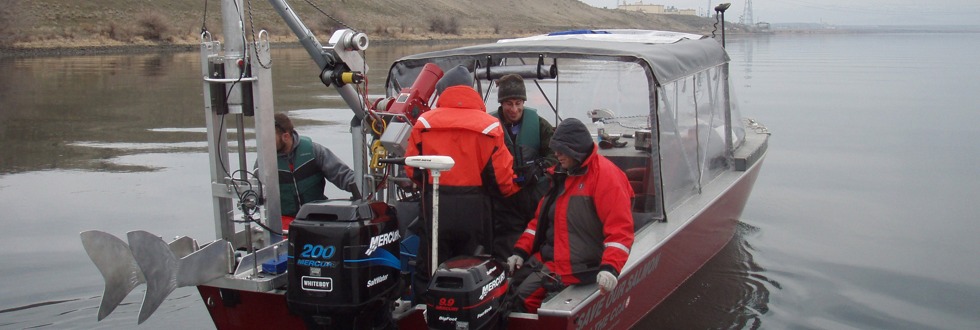Featured Projects
U.S. Department of Energy, Washington Closure Hanford
Remedial Investigation of Hanford Site Releases to the Columbia River
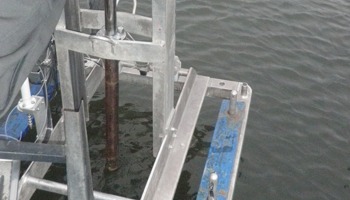
Using a split-frame sampler to locate and more precisely measure contaminants
Upland, riparian, and near-shore areas bordering the Hanford Site 100 and 300 Areas form part of the 214-mile Columbia River Corridor. The Hanford span of the River Corridor contains deactivated plutonium-production reactors, numerous support facilities, and liquid and solid waste disposal sites that have contaminated soil and groundwater. Natural resources in the corridor may be at risk from groundwater contaminated by past site operations discharging (upwelling) into the Columbia River. To protect natural resources and human health, DOE and federal and state regulators have expedited remediation of the River Corridor.
EAS collected more than 1,100 new samples between 2008 and 2010 to measure concentrations of contaminants in aquatic media in support of DOE’s Remedial Investigation of Hanford Site Releases to the Columbia River. We sampled, evaluated, and reported on surface water and pore water, sediment, and fish. EAS led work to collect, process, and ship samples; assess sample specimen conditions; and interpret field measures and contaminant results. The EAS team safely performed this project with staff working more than 8,000 field hours and 600 boat days in, at times, extreme environmental conditions (in winter, at night). EAS successfully performed all contract requirements, including effective management of two subcontractors, on time and within budget.
Surface and Pore Water Sampling Using the Liquid-Tip Trident Probe. The nature and extent of contaminated groundwater that enters into the riverbeds of the Columbia River has been a major data gap for more than 40 years. In response to this data gap, EAS proposed an innovative approach and performed a proof-of-principle study using an advanced groundwater upwelling mapping and sampling tool. Using this tool allowed DOE to locate and more precisely measure chemicals and radionuclides in areas of the riverbed where groundwater upwellings occur.
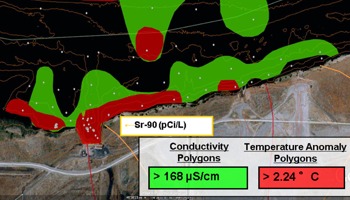
Mapping groundwater upwelling patterns (conductivity and temperature)
The liquid-tip Trident probe and ruggedized driving frame is a proprietary technology designed for sustained use in complex, offshore riverine environments. EAS collaborated with the probe’s developer to tailor it specifically for the complexities of Columbia River hydrology and geology. EAS staff also performed a series of field studies and ran river flow models to develop a river-stage-specified sampling program. This was the first time river flow data had been incorporated into pore water sampling in the history of the Hanford Site. These investigations provided DOE, regulators, tribes, and stakeholders with verifiable data to make decisions on waste site and groundwater remediation actions in the Columbia River Corridor.
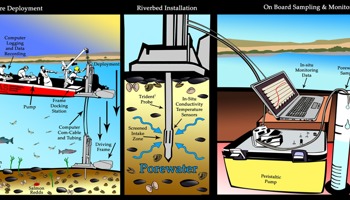
Deploying in-situ conductivity temperature sensors to sample porewater
Sediment Sampling. The EAS team collected samples of sediment—the loose material in the river bottom that can move with the river flow—at the same locations as pore water to estimate concentrations near areas of contaminated groundwater upwellings. We adapted a split-spoon sampler to the newly developed offshore driving frame of the Trident probe to consistently collect samples within rocky substrates and in deep, fast-flowing water. In the history of Hanford Site operations, no sampling team has been able to successfully demonstrate a safe, rapid, and effective means to collect samples at these locations.
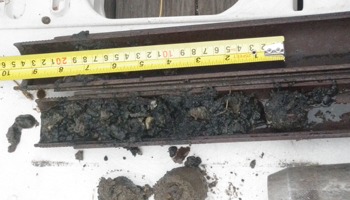
Analyzing sediment samples to estimate contaminant concentrations
Washington Closure Hanford publically released several reports related to remedial investigations of Hanford Site releases to the Columbia River, including the following:
- Field Summary Report for Remedial Investigation of Hanford Site Releases to the Columbia River, Hanford Site, Washington: Collection of Surface Water, Pore Water, and Sediment Samples for Characterization of Groundwater Upwelling, July 2010, WCH-380 Rev. 0.
This report can be found at: https://www.washingtonclosure.com/documents/mission_complete/WCH-380%20Rev.%200/WCH-380%20Rev%200.pdf
- Data Summary Report for the Remedial Investigation of Hanford Site Releases to the Columbia River, Hanford Site, Washington, January 2011, WCH-398 Rev. 0.
This report can be found at: https://www.washingtonclosure.com/documents/mission_complete/WCH-398_Rev.0/WCH-398 Rev. 0 Sections 1-8.pdf
- Data Summary Report for the Remedial Investigation of Hanford Site Releases to the Columbia River, Hanford Site, Washington, January 2011, WCH-398 rev. 0. Appendix A-K, Boxplots for Inclusion List Analytes and Other Constituents of Interest that were Detected in Any Sample.
This report can be found at: https://www.washingtonclosure.com/documents/mission_complete/WCH-398_Rev.0/WCH-398%20Rev.%200%20App%20A-K.pdf
- Data Summary Report for the Remedial Investigation of Hanford Site Releases to the Columbia River, Hanford Site, Washington, January 2011, WCH-398 rev. 0. Appendix L, Island Soil, Sediment, Surface Water and Pore Water Sample Locations 2008- 2010.
This report can be found at: https://www.washingtonclosure.com/documents/mission_complete/WCH-398_Rev.0/WCH-398%20Rev.%200%20App%20L.pdf
Fish Sampling. During 2009 and 2010, as part of the Fish Sampling Program, the field team collected 600 specimens of six different species of fish to assess their condition and risk to the public from consuming the fish. Fish were targeted for sampling to characterize the nature and extent of Hanford Site-related contaminants in the Columbia River and assess risk to ecological and human health receptors that is posed by these contaminants.
EAS conducted fish sampling from just above Wanapum Dam to McNary Dam to obtain tissue samples from targeted species, including whitefish, bass, sturgeon, suckers, carp, and walleye. These fish were selected for study because they are year-round Columbia River residents, and local residents frequently catch these species. We homogenized samples at our laboratory and developed a process to quantify the amount of sediment incidentally ingested by sturgeon to better characterize radiological doses.
Specific objectives for this project were to: characterize concentrations of analytes in each target fish species and the distribution of Hanford Site-related contaminants in different parts of fish; confirm detections of target analytes in fish samples collected and analyzed during previous investigations; establish background concentrations of contaminants in fish collected from areas of the river not impacted by activities associated with the Hanford Site; estimate which areas of the river contained fish with the highest concentrations of Hanford Site-related contaminants; evaluate and summarize the variability of concentrations of contaminants within each fish species and between different species; and provide data for current and future evaluations of ecological risk.
To date, this project represents the largest single fish sampling, processing, and evaluation effort conducted in support of the Hanford Site cleanup mission.
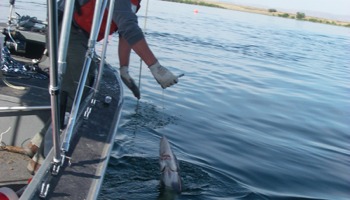
Sampling sturgeon to assess condition and risk to the public from consuming this species
Washington Closure Hanford publically released three reports related to fish sampling investigations of Hanford Site releases to the Columbia River, including the following:
- Field Summary Report for Remedial Investigation of Hanford Site Releases to the Columbia River, Hanford Site, Washington: Collection of Fish Tissue Samples, September 2010, Washington Closure Hanford, WCH-387.
This report can be found at: https://www.washingtonclosure.com/documents/mission_complete/WCH-387%20Rev.%200/WCH-387%20Rev%200.pdf
- Data Summary Report for the Remedial Investigation of Hanford Site Releases to the Columbia River, Hanford Site, Washington, January 2011, WCH-398 rev. 0. Appendix M, Fish Sample Locations 2009- 2010.
This report can be found at: https://www.washingtonclosure.com/documents/mission_complete/WCH-398_Rev.0/WCH-398%20Rev.%200%20App%20M.pdf
- Data Summary Report for the Remedial Investigation of Hanford Site Releases to the Columbia River, Hanford Site, Washington, January 2011, WCH-398 rev. 0. Appendix N, Box Plots and Summary Statistics for Inclusion List Analytes and Other Constituents of Interest for Sturgeon Viscera.
This report can be found at: https://www.washingtonclosure.com/documents/mission_complete/WCH-398_Rev.0/WCH-398%20Rev.%200%20App%20N-P.pdf
U.S. Department of Energy, CH2 Plateau Remediation Contractor (CHPRC)
Pore Water Sampling in Support of 100-B/C, 100-N, and 100-F Areas RI/FS
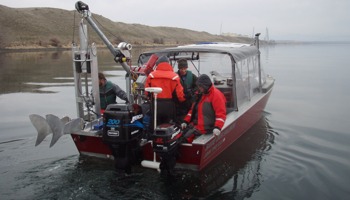
Deploying liquid Trident probe to sample complex and normally difficult-to-sample riverbed substrates
During Hanford Site plutonium production, some contaminants were released to the Columbia River and others to the soil at nuclear reactor sites or as unplanned spills or leaks. Contaminants migrated from soil into the groundwater and eventually discharged into the Columbia River near the Hanford 100 Areas. These discharges, known as upwellings, occur where groundwater seeps up into the river bottom in spaces between rocks and sediment. The water in these sediments is called pore water.
EAS carried out the first successful pore-water sampling and groundwater upwelling mapping project in the Columbia River for the Department of Energy. We conducted additional pore-water sampling near the sites of three former nuclear reactors in fall/winter 2010 and 2011. Our work supported the Sampling and Analysis Plan for the 100-BC-1, 100-BC-2, and 100-BC-5 Operable Units Remedial Investigation/Feasibility Studies. The purpose of these studies was to evaluate the presence of chromium and hexavalent chromium Cr(VI) in the riverbed and assess their levels and extent in the most biologically active region of the river.
We used the patented liquid-tip Trident probe to sample and characterize pore water and sediment in the riverbed. The probe provides an important tool in our groundwater upwelling studies because it has proven effective in sampling the Columbia River’s complex and normally difficult-to-sample riverbed substrates. Collaborating with the probe’s developer, EAS was instrumental in tailoring the technology specifically for the Columbia’s offshore waters and coarse riverbed. We also worked with the developer to integrate river stage-specified field deployment techniques because EAS’s experience shows the importance of the Columbia River’s stage (level) on groundwater discharge patterns and contaminant concentrations. This was crucial in obtaining results that were relatively comparable across space and over time.
Since 2010, CHPRC has publically released the following reports related to Columbia River pore water sampling:
- Columbia River Pore Water Sampling in 100-BC Area, November 2010, CHPRC, SGW-49368, Revision 0.
This document can be found at: http://pdw.hanford.gov/arpir/index.cfm/viewDoc?accession=1107060717
- Columbia River Pore Water Sampling in 100-F Area, February 2011, CHPRC, SGW-49575, Revision 0.
This document can be found at: http://pdw.hanford.gov/arpir/index.cfm/viewDoc?accession=1107060718
U.S. Department of Energy, CH2 Plateau Remediation Contractor (CHPRC)
Installation of Hyporheic Sampling Points (HSPs) in the 100-BC Area
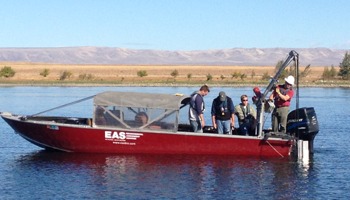
Deploying tailored liquid-tip Trident probe to install hyporheic sampling points
The hyporheic zone is the region of the riverbed where groundwater and surface water mix and upwelling occurs. Scientists believe it is one of the most challenging zones of a river to investigate, particularly in the offshore waters and coarse riverbeds of the Columbia River.
EAS was awarded the CHPRC contract to build and install 22 hyporheic sampling points in the Columbia River near the 100-BC-5 Area of the Hanford Site. The purpose of the project was to better define the level of hexavalent chromium in the river substrate, describe changes in concentrations under varying river stages, and assess potential effects to aquatic receptors.
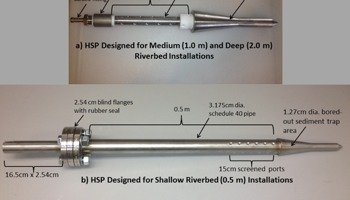
Hyporheic sampling points
EAS provided CHPRC an unparalleled understanding of the intricacies of performing all the work detailed in their statement of work. Given our experience in using the liquid-tip Trident probe to confirm the presence of groundwater upwelling in the Columbia riverbed, we were uniquely suited to determine the in-situ pore water pump rates and the likelihood of installing HSPs to the target riverbed depths. Collaborating with the liquid tip Trident probe's inventors, EAS was instrumental in tailoring the probe specifically to the Columbia River and its complexities and integrating river stage-specified field deployment techniques.
With the necessary laboratory space, equipment storage space, established waste streams for Trident probe calibration solutions, and equipment loading docks for our vessels in Richland, Washington, EAS was able to rapidly mobilize and execute all elements of the project. Our commitment included providing CHPRC all the necessary vehicles, vessels, and equipment specified in the statement of work as well as a technical resource team of experienced liquid-tip Trident probe and driving frame operators, boat captains, deck-hands, and hydro-geologists to safely and effectively support implementation of all project activities.

Developing a hyporheic sampling process to ensure varying river stages won’t affect approach or schedule
Notably, EAS was the only subcontractor capable of ensuring that varying river stages would not affect the planned approach or schedule to install the 14 shallow hyporheic sampling points. Additionally, EAS’s approach provided CHPRC real-time in-situ upwelling verification and pump rate determinations during the installation process. Other conventional approaches would not allow in-situ real-time monitoring. EAS successfully performed the HSP installations on time and within budget with zero safety incidents.
U.S. Department of Energy Contractor
Hanford Water Tank Storage Inspections
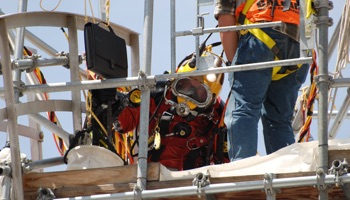
Diver entering steel water storage tank
The National Fire Protection Association and American Water Works Association require periodic inspection, testing, and maintenance of water-based fire protection systems. This includes evaluating thousands of steel water storage tanks that have been constructed to store potable water in systems nationwide. At the Hanford Site, above ground steel tanks are used as part of fire protection and potable water systems in several areas, including the 100, 200, and 400 Areas.

Assisting diver from top of water tank
To ensure compliance with applicable requirements, EAS led a team to perform interior tank inspections underwater. Certified divers safely and successfully conducted internal steel water tank inspections, cleaning, and minor repair work in four Hanford Site water storage tanks according to operational safety and health standards. The elevated tanks ranged in size from 300-thousand gallons to 750-thousand gallons. While working underwater in confined spaces, divers were required to videotape the tank inspections to ensure project objectives were met. EAS safely performed more than 4,000 worker hours on the this contract with no QA/QC issues.
